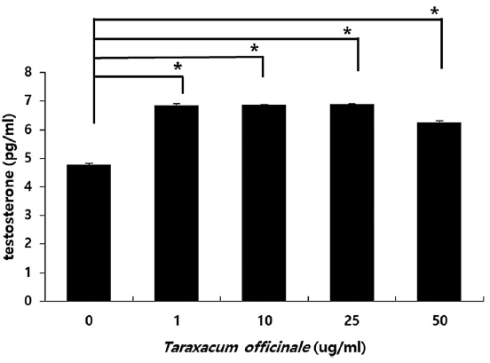|
Testosterone levels go off the scale with holy basil
Holy basil, or Ocimum sanctum, is an herb that originally comes from India. In animal studies done at Sharma University of Health Sciences it sends testosterone levels so high that researchers can't measure them. And no, they weren't using high-tech extracts, but ordinary fresh leaves of the plant.
Holy basil
Holy basil goes by the name of tulsi in India. In Asia it is used for cooking and in Ayurvedic medicine. Ocimum sanctum contains among other things oleanolic acid, ursolic acid, rosmarinic acid, eugenol, carvacrol, linalool and beta-caryophyllene.
In Ayurvedic medicine Ocimum sanctum is ascribed adaptogenic properties, capable even of protecting against radioactive radiation [Indian J Exp Biol. 1995 Mar; 33(3): 205-8.], and life extending properties too. Text books refer to its medicinal use for treating colds, headache, stomach complaints, inflammations, cardiovascular disease [BMC Complement Altern Med. 2006 Feb 19; 6:3.], malaria and poisoning, for example through arsenic [Food Chem Toxicol. 2009 Feb; 47(2): 490-5.].
Study
The researchers' interest in Ocimum sanctum was piqued by a less well-known use: in some villages women use the herb as a contraceptive. The researchers decided to see if they could confirm this effect in animal studies, and gave male rabbits weighing 2 kg a daily 2 g of fresh leaves for 30 days.
Results
The extract worked. The figure below shows that Ocimum sanctum reduced the concentration of sperm in the seminal fluid by 45 percent. Even stronger though was the effect on the testosterone level: this rose by no less than factor five in the rabbits who ate the leaves.

The equipment the researchers used to measure the concentration of testosterone in the blood of the lab animals was capable of measuring up to 1500 nanograms per decilitre. Ocimum sanctum caused the level of testosterone to rise above this cut-off point.
The FSH concentration went down by a factor five as a result of the herb, and the LH concentration even dropped of the bottom of the scale.

Conclusion
"A possible hypothesis to explain this pattern of changes in hormone levels could be that Ocimum sanctum leaves probably contain some androgenic analogue, which increased the circulating testosterone levels sufficiently to inhibit LH but not sufficient to accumulate in the testis at the required concentration for normal spermatogenesis", the researchers write.
"However, the decreased LH levels will diminish intratesticular production of testosterone by Leydig cells, which results in reduced levels of spermatogenesis."
Source:
Int J Ayurveda Res. 2010 Oct-Dec 1(4):208-210.
More:
The Viagra effect of testosterone booster Bulbine natalensis 01.03.2011
Flavonoid in Horny Goat Weed boosts testosterone 22.11.2010
Forskolin: slimming aid and testosterone booster all in one 02.11.2010
Archives:
Boosting Testosterone
|
|







